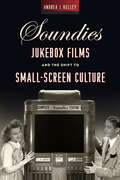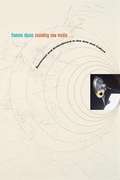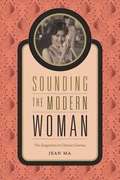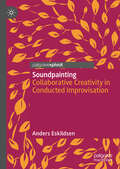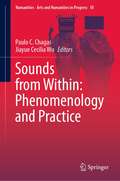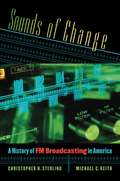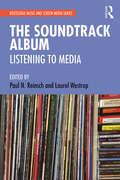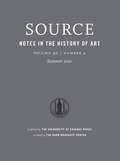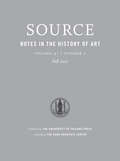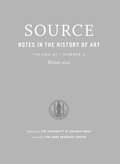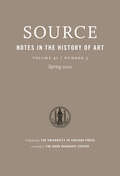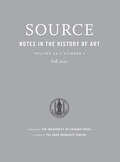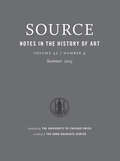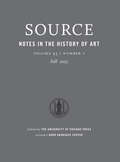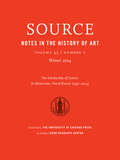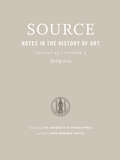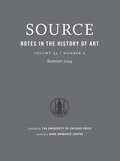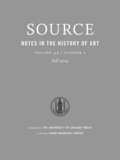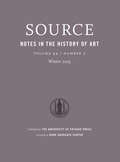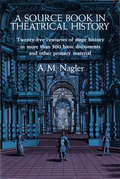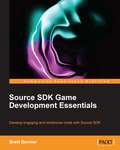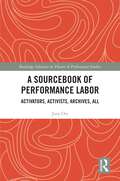- Table View
- List View
Soundies Jukebox Films and the Shift to Small-Screen Culture (Techniques of the Moving Image)
by Andrea J. KelleySoundies Jukebox Films and the Shift to Small-Screen Culture is the first and only book to position what are called “Soundies” within the broader cultural and technological milieu of the 1940s. From 1940 to 1946, these musical films circulated in everyday venues, including bars, bowling alleys, train stations, hospitals, and even military bases. Viewers would pay a dime to watch them playing on the small screens of the Panoram jukebox. This book expands U.S. film history beyond both Hollywood and institutional film practices. Examining the dynamics between Soundies’ short musical films, the Panoram’s film-jukebox technology, their screening spaces and their popular discourse, Andrea J. Kelley provides an integrative approach to historic media exhibition. She situates the material conditions of Soundies’ screening sites alongside formal considerations of the films and their unique politics of representation to illuminate a formative moment in the history of the small screen.
Sounding New Media: Immersion and Embodiment in the Arts and Culture
by Frances DysonThe concept of embodiment, as either a site of resistance to technological incorporation, or a site of excess toward which technology will always aim but never arrive, is no longer adequate to represent the realities of technoculture.
Sounding the Modern Woman: The Songstress in Chinese Cinema
by Jean MaFrom the beginning of the sound cinema era, singing actresses captivated Chinese audiences. In Sounding the Modern Woman, Jean Ma shows how their rise to stardom attests to the changing roles of women in urban modernity and the complex symbiosis between the film and music industries. The songstress--whether appearing as an opera actress, showgirl, revolutionary, or country lass--belongs to the lineage of the Chinese modern woman, and her forty year prevalence points to a distinctive gendering of lyrical expression in Chinese film. Ma guides readers through film history by way of the on and off-screen careers of many of the most compelling performers in Chinese film history, such as Zhou Xuan and Grace Chang, revealing the ways that national crises and Cold War conflict shaped their celebrity. As a bridge between the film cultures of prewar Shanghai and postwar Hong Kong, the songstress brings into view a dense web of connections linking these two periods and places that cut across the divides of war, national politics, and geography.
Soundpainting: Collaborative Creativity in Conducted Improvisation (Palgrave Studies in Sound)
by Anders EskildsenThis book explores Soundpainting, a multidisciplinary sign language for live composition and conducted improvisation, highlighting its role in facilitating creative, social interactions in music and other performative arts. Examining the meaning of Soundpainting’s syntax, the connection between constraints and creativity in hand signs, and the means for dynamic distribution and transformation of agency within ensembles, the book provides insight into the nature of cocreation and the organization of creative processes.
Sounds from Within: Phenomenology and Practice (Numanities - Arts and Humanities in Progress #18)
by Paulo C. Chagas Jiayue Cecilia WuThis book transforms phenomenology, music, technology, and the cultural arts from within. Gathering contributions by performing artists, media technology designers, nomadic composers, and distinguished musicological scholars, it explores a rich array of concepts such as embodiment, art and technology, mindfulness meditation, time and space in music, self and emptiness, as well as cultural heritage preservation. It does so via close studies on music phenomenology theory, works involving experimental music and technology, and related cultural and historical issues. This book will be of considerable interest to readers from the fields of sound studies, science and technology studies, phenomenology, cultural studies, media studies, and sound art theory. This book is equally relevant and insightful for musicians, composers, media artists, sound artists, technology designers, and curators and arts administrators from the performing and visual arts.
Sounds Like Helicopters: Classical Music in Modernist Cinema (SUNY series, Horizons of Cinema)
by Matthew LauExplores how modernist films use classical music in ways that restore the music's original subversive energy.Classical music masterworks have long played a key supporting role in the movies-silent films were often accompanied by a pianist or even a full orchestra playing classical or theatrical repertory music-yet the complexity of this role has thus far been underappreciated. Sounds Like Helicopters corrects this oversight through close interpretations of classical music works in key modernist films by Francis Ford Coppola, Werner Herzog, Luis Buñuel, Stanley Kubrick, Jean-Luc Godard, Michael Haneke, and Terrence Malick. Beginning with the famous example of Wagner's "Ride of the Valkyries" in Apocalypse Now, Matthew Lau demonstrates that there is a significant continuity between classical music and modernist cinema that belies their seemingly ironic juxtaposition. Though often regarded as a stuffy, conservative art form, classical music has a venerable avant-garde tradition, and key films by important directors show that modernist cinema restores the original subversive energy of these classical masterworks. These films, Lau argues, remind us of what this music sounded like when it was still new and difficult; they remind us that great music remains new music. The pattern of reliance on classical music by modernist directors suggests it is not enough to watch modernist cinema: one must listen to its music to sense its prehistory, its history, and its obscure, prophetic future.
Sounds of Change
by Michael C. Keith Christopher H. SterlingWhen it first appeared in the 1930s, FM radio was a technological marvel, providing better sound and nearly eliminating the static that plagued AM stations. It took another forty years, however, for FM's popularity to surpass that of AM. In Sounds of Change, Christopher Sterling and Michael Keith detail the history of FM, from its inception to its dominance (for now, at least) of the airwaves.Initially, FM's identity as a separate service was stifled, since most FM outlets were AM-owned and simply simulcast AM programming and advertising. A wartime hiatus followed by the rise of television precipitated the failure of hundreds of FM stations. As Sterling and Keith explain, the 1960s brought FCC regulations allowing stereo transmission and requiring FM programs to differ from those broadcast on co-owned AM stations. Forced nonduplication led some FM stations to branch out into experimental programming, which attracted the counterculture movement, minority groups, and noncommercial public and college radio. By 1979, mainstream commercial FM was finally reaching larger audiences than AM. The story of FM since 1980, the authors say, is the story of radio, especially in its many musical formats. But trouble looms. Sterling and Keith conclude by looking ahead to the age of digital radio--which includes satellite and internet stations as well as terrestrial stations--suggesting that FM's decline will be partly a result of self-inflicted wounds--bland programming, excessive advertising, and little variety.When it first appeared in the 1930s, FM radio was a technological marvel, providing better sound and nearly eliminating the static that plagued AM stations. It took another forty years, however, for FM's popularity to surpass that of AM. In Sounds of Change, Christopher Sterling and Michael Keith detail the history of FM, from its inception to its dominance (for now, at least) of the airwaves.Initially, FM's identity as a separate service was stifled, since most FM outlets were AM-owned and simply simulcast AM programming and advertising. But the 1960s brought FCC regulations allowing stereo transmission and requiring FM programs to differ from those broadcast on co-owned AM stations. Branching out into experimental programming, FM soon attracted the counterculture movement, minority groups, and noncommercial public and college radio. By 1979, mainstream commercial FM was finally reaching larger audiences than AM. Recent decades have been FM's heyday. But trouble looms. Sterling and Keith conclude by looking ahead to the age of digital radio--which includes satellite and internet stations as well as terrestrial stations--suggesting that FM's eventual decline will be partly a result of self-inflicted wounds--bland programming, excessive advertising, and little variety.-->
The Soundtrack Album: Listening to Media
by Paul Reinsch Laurel WestrupThe Soundtrack Album: Listening to Media offers the first sustained exploration of the soundtrack album as a distinctive form of media. Soundtrack albums have been part of our media and musical landscape for decades, enduring across formats from vinyl and 8-tracks to streaming playlists. This book makes the case that soundtrack albums are more than promotional tools for films, television shows, or video games— they are complex media texts that reward a detailed analysis. The collection’s contributors explore a diverse range of soundtrack albums, from Super Fly to Stranger Things, revealing how these albums change our understanding of the music and film industries and the audio-visual relationships that drive them. An excellent resource for students of Music, Media Studies, and Film/Screen Media courses, The Soundtrack Album offers interdisciplinary perspectives and opens new areas for exploration in music and media studies.
Source: Notes in the History of Art, volume 40 number 4 (Summer 2021)
by Source: Notes in the History of ArtThis is volume 40 issue 4 of Source: Notes in the History of Art. Source was founded in 1981 as a scholarly journal in art history. Its mission is to publish articles of 2,500 words or less, accompanied by a maximum of three illustrations. The range of articles spans antiquity to the present and includes western and non-western art. The original premise has been borne out: there is an audience for scholarly articles in art history that are clearly written, adequately illustrated and above all, succinct. Furthermore, scholars welcome having a forum to present ideas and speculations that don’t warrant a major treatise, but might nevertheless make interesting “notes” for specialists and non-specialists alike.
Source: Notes in the History of Art, volume 41 number 1 (Fall 2021)
by Source: Notes in the History of ArtThis is volume 41 issue 1 of Source: Notes in the History of Art. Source was founded in 1981 as a scholarly journal in art history. Its mission is to publish articles of 2,500 words or less, accompanied by a maximum of three illustrations. The range of articles spans antiquity to the present and includes western and non-western art. The original premise has been borne out: there is an audience for scholarly articles in art history that are clearly written, adequately illustrated and above all, succinct. Furthermore, scholars welcome having a forum to present ideas and speculations that don’t warrant a major treatise, but might nevertheless make interesting “notes” for specialists and non-specialists alike.
Source: Notes in the History of Art, volume 41 number 2 (Winter 2022)
by Source: Notes in the History of ArtThis is volume 41 issue 2 of Source: Notes in the History of Art. Source was founded in 1981 as a scholarly journal in art history. Its mission is to publish articles of 2,500 words or less, accompanied by a maximum of three illustrations. The range of articles spans antiquity to the present and includes western and non-western art. The original premise has been borne out: there is an audience for scholarly articles in art history that are clearly written, adequately illustrated and above all, succinct. Furthermore, scholars welcome having a forum to present ideas and speculations that don’t warrant a major treatise, but might nevertheless make interesting “notes” for specialists and non-specialists alike.
Source: Notes in the History of Art, volume 41 number 3 (Spring 2022)
by Source: Notes in the History of ArtThis is volume 41 issue 3 of Source: Notes in the History of Art. Source was founded in 1981 as a scholarly journal in art history. Its mission is to publish articles of 2,500 words or less, accompanied by a maximum of three illustrations. The range of articles spans antiquity to the present and includes western and non-western art. The original premise has been borne out: there is an audience for scholarly articles in art history that are clearly written, adequately illustrated and above all, succinct. Furthermore, scholars welcome having a forum to present ideas and speculations that don’t warrant a major treatise, but might nevertheless make interesting “notes” for specialists and non-specialists alike.
Source: Notes in the History of Art, volume 41 number 4 (Summer 2022)
by Source: Notes in the History of ArtThis is volume 41 issue 4 of Source: Notes in the History of Art. Source was founded in 1981 as a scholarly journal in art history. Its mission is to publish articles of 2,500 words or less, accompanied by a maximum of three illustrations. The range of articles spans antiquity to the present and includes western and non-western art. The original premise has been borne out: there is an audience for scholarly articles in art history that are clearly written, adequately illustrated and above all, succinct. Furthermore, scholars welcome having a forum to present ideas and speculations that don’t warrant a major treatise, but might nevertheless make interesting “notes” for specialists and non-specialists alike.
Source: Notes in the History of Art, volume 42 number 1 (Fall 2022)
by Source: Notes in the History of ArtThis is volume 42 issue 1 of Source: Notes in the History of Art. Source was founded in 1981 as a scholarly journal in art history. Its mission is to publish articles of 2,500 words or less, accompanied by a maximum of three illustrations. The range of articles spans antiquity to the present and includes western and non-western art. The original premise has been borne out: there is an audience for scholarly articles in art history that are clearly written, adequately illustrated and above all, succinct. Furthermore, scholars welcome having a forum to present ideas and speculations that don’t warrant a major treatise, but might nevertheless make interesting “notes” for specialists and non-specialists alike.
Source: Notes in the History of Art, volume 42 number 2 (Winter 2023)
by Source: Notes in the History of ArtThis is volume 42 issue 2 of Source: Notes in the History of Art. Source was founded in 1981 as a scholarly journal in art history. Its mission is to publish articles of 2,500 words or less, accompanied by a maximum of three illustrations. The range of articles spans antiquity to the present and includes western and non-western art. The original premise has been borne out: there is an audience for scholarly articles in art history that are clearly written, adequately illustrated and above all, succinct. Furthermore, scholars welcome having a forum to present ideas and speculations that don’t warrant a major treatise, but might nevertheless make interesting “notes” for specialists and non-specialists alike.
Source: Notes in the History of Art, volume 42 number 4 (Summer 2023)
by Source: Notes in the History of ArtThis is volume 42 issue 4 of Source: Notes in the History of Art. Source was founded in 1981 as a scholarly journal in art history. Its mission is to publish articles of 2,500 words or less, accompanied by a maximum of three illustrations. The range of articles spans antiquity to the present and includes western and non-western art. The original premise has been borne out: there is an audience for scholarly articles in art history that are clearly written, adequately illustrated and above all, succinct. Furthermore, scholars welcome having a forum to present ideas and speculations that don’t warrant a major treatise, but might nevertheless make interesting “notes” for specialists and non-specialists alike.
Source: Notes in the History of Art, volume 43 number 1 (Fall 2023)
by Source: Notes in the History of ArtThis is volume 43 issue 1 of Source: Notes in the History of Art. Source was founded in 1981 as a scholarly journal in art history. Its mission is to publish articles of 2,500 words or less, accompanied by a maximum of three illustrations. The range of articles spans antiquity to the present and includes western and non-western art. The original premise has been borne out: there is an audience for scholarly articles in art history that are clearly written, adequately illustrated and above all, succinct. Furthermore, scholars welcome having a forum to present ideas and speculations that don’t warrant a major treatise, but might nevertheless make interesting “notes” for specialists and non-specialists alike.
Source: Notes in the History of Art, volume 43 number 2 (Winter 2024)
by Source: Notes in the History of ArtThis is volume 43 issue 2 of Source: Notes in the History of Art. Source was founded in 1981 as a scholarly journal in art history. Its mission is to publish articles of 2,500 words or less, accompanied by a maximum of three illustrations. The range of articles spans antiquity to the present and includes western and non-western art. The original premise has been borne out: there is an audience for scholarly articles in art history that are clearly written, adequately illustrated and above all, succinct. Furthermore, scholars welcome having a forum to present ideas and speculations that don’t warrant a major treatise, but might nevertheless make interesting “notes” for specialists and non-specialists alike.
Source: Notes in the History of Art, volume 43 number 3 (Spring 2024)
by Source: Notes in the History of ArtThis is volume 43 issue 3 of Source: Notes in the History of Art. Source was founded in 1981 as a scholarly journal in art history. Its mission is to publish articles of 2,500 words or less, accompanied by a maximum of three illustrations. The range of articles spans antiquity to the present and includes western and non-western art. The original premise has been borne out: there is an audience for scholarly articles in art history that are clearly written, adequately illustrated and above all, succinct. Furthermore, scholars welcome having a forum to present ideas and speculations that don’t warrant a major treatise, but might nevertheless make interesting “notes” for specialists and non-specialists alike.
Source: Notes in the History of Art, volume 43 number 4 (Summer 2024)
by Source: Notes in the History of ArtThis is volume 43 issue 4 of Source: Notes in the History of Art. Source was founded in 1981 as a scholarly journal in art history. Its mission is to publish articles of 2,500 words or less, accompanied by a maximum of three illustrations. The range of articles spans antiquity to the present and includes western and non-western art. The original premise has been borne out: there is an audience for scholarly articles in art history that are clearly written, adequately illustrated and above all, succinct. Furthermore, scholars welcome having a forum to present ideas and speculations that don’t warrant a major treatise, but might nevertheless make interesting “notes” for specialists and non-specialists alike.
Source: Notes in the History of Art, volume 44 number 1 (Fall 2024)
by Source: Notes in the History of ArtThis is volume 44 issue 1 of Source: Notes in the History of Art. Source was founded in 1981 as a scholarly journal in art history. Its mission is to publish articles of 2,500 words or less, accompanied by a maximum of three illustrations. The range of articles spans antiquity to the present and includes western and non-western art. The original premise has been borne out: there is an audience for scholarly articles in art history that are clearly written, adequately illustrated and above all, succinct. Furthermore, scholars welcome having a forum to present ideas and speculations that don’t warrant a major treatise, but might nevertheless make interesting “notes” for specialists and non-specialists alike.
Source: Notes in the History of Art, volume 44 number 2 (Winter 2025)
by Source: Notes in the History of ArtThis is volume 44 issue 2 of Source: Notes in the History of Art. Source was founded in 1981 as a scholarly journal in art history. Its mission is to publish articles of 2,500 words or less, accompanied by a maximum of three illustrations. The range of articles spans antiquity to the present and includes western and non-western art. The original premise has been borne out: there is an audience for scholarly articles in art history that are clearly written, adequately illustrated and above all, succinct. Furthermore, scholars welcome having a forum to present ideas and speculations that don’t warrant a major treatise, but might nevertheless make interesting “notes” for specialists and non-specialists alike.
A Source Book in Theatrical History
by A. M. NaglerA rich resource for students of theater and theater historians, this volume features an annotated collection of more than 300 unusually interesting and detailed articles. Passages by contemporary observers from ancient Greece to modern times include notes on acting, directing, make-up, costuming, stage props, machinery, scene design, and much more.
Source SDK Game Development Essentials
by Brett BernierThis book is written by a gamer, for a gamer to guide just about anything with Source SDK giving a firm grasp of all the tools it has to offer using step-by-step explanations. If you're a keen gamer who wants a bit more out of your favorite game and create your own modifications (mods) and levels with the Source engine, this book is great for you. No programming and Source SDK experience is required.
A Sourcebook of Performance Labor: Activators, Activists, Archives, All (Routledge Advances in Theatre & Performance Studies)
by Joey OrrA Sourcebook of Performance Labor presents the views and experiences of collaborators in other artists’ works. This book reorients well-known works of contemporary performance and social practice around the workers who have shaped, enacted, and supported them. It emerges from perspectives on maintenance, care, affective labor, and the knowledges created and preserved through gesture and intersubjectivity. This compilation of interviews is filled with the voices of collaborators in notable works attributed to established contemporary artists, including Francis Alÿs, Tania Bruguera, Suzanne Lacy, Ernesto Pujol, Asad Raza, Dread Scott, and Tino Sehgal. In the spirit of the artworks under discussion, this book reinvests in the possibilities for art as a collective effort to explore new ways of finding ourselves in others and others in ourselves. The Sourcebook collection is a contribution for further theorizing a largely unaddressed perspective in contemporary art. This collection will be of great interest to students and scholars in performance studies and art history.
